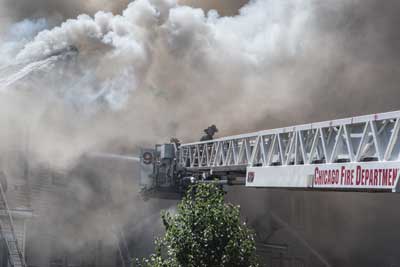BY JOHN F. “SKIP” COLEMAN, TECHNICAL EDITOR
THE PREVIOUS ROUNDTABLE question concerned tornado policies and procedures. Another aspect of natural disasters is working with the public utility companies that also respond to these emergencies. Down power lines, natural gas line ruptures, and water main breaks are just some of the concerns the utility companies and first responders have during a natural disaster.
Roundtable: Do you train with your local utility companies on emergency procedures? To post your comments, go to fireengineering.com/roundtable.html.
Webcasts
Join us for monthly Webcasts featuring the best of Fire Engineering authors and FDIC speakers. On September 19, 2013, Pat Grubb, vice president, ESI Equipment, Inc. & Junk Yard Dog Industries, will present “Hydraulic Tool Maintenance.” He says, “It is essential that hydraulic pumps, hoses, tools, and accessories are ready when someone is trapped and in need of extrication. Rescuers cannot schedule when they will be dispatched and responding with their equipment.” The Webcast is sponsored by Holmatro and is free, but you must register!
 |
| PHOTO OF THE DAY: The Chicago (IL) Fire Department responded to a fire in four wood-frame dwellings. The fire appeared to be heaviest in the rear. Members used numerous handlines and a tower ladder. Because the fire was in a congested area, many units stretched lines down gangways from the next block over. (Photo by Steve Redick/www.ksc711.smugmug.com.) See more photos at http://emberly.fireengineering.com/photo-of-the-day.html. Send your Photo of the Day submissions to Peter Prochilo (peterp@pennwell.com). |
FIRE LIFE
In her article “Preplan for Health Battles as for Fireground Battles” (To Your Health column), Mary Jane Dittmar writes: “Just as fireground battles can be successful only if firefighters preplan and drill BEFORE the fire, the greatest chance for success in a ‘health battle’ lies in our researching and preplanning-in our engaging in ‘what- if’ exercises before a serious health problem arises.” See more at www.firelife.com.
FEATURED ARTICLES
Gregory Havel, deputy chief and training officer (ret.), Burlington (WI) Fire Department, writes in “The 20-Minute Rule”: “In his book Fireground Tactics, Emmanuel Fried stated in 1972, ‘When the fire has substantially involved more than one floor and is out of control after 20 minutes of inside operation, back all companies out and resort to the use of exterior streams. You may lose the building, but you may save your men.’ With today’s construction, this rule needs to be amended.” (http://bit.ly/13e2fC7)
David DeStefano, lieutenant, North Providence (RI) Fire Department, writes in “AAA: Triangle of Incident Survivability”: “A substantive process to enhance fireground survival may be explained as the ‘triple A’ triangle of incident survivability. The protective sides of the triangle include anticipation, action, and analysis. Just as the triangle is a strong geometric shape as long as all sides remain in place and connected, the ‘AAA’ triangle remains most effective when firefighters fully employ each of these elements.” (ttp://bit.ly/15yl4i6)
Becki White, Minnesota deputy state fire marshal and captain, Eden Prairie (MN) Fire Department, writes in “Reach Out to Your Community and Sound the Alarm”: “I wonder if the headline might have been different if they had invested $20 in a smoke alarm or $3 in fresh batteries. I think about how sad it is that they could have had an alarm on the ceiling and a drawer full of nine-volt batteries, but they hadn’t pushed the test button recently to discover that the alarm batteries were no longer working.” (http://bit.ly/17geiin)
Mike Donahue, firefighter, Elizabeth (NJ) Fire Department, writes in “Rigging Outside the Box”: “I’d like to share an outside-the-box moment I recently had in a rope class I was teaching. To me the best part of this experience was that the problem at hand had everyone thinking; everyone was attempting to push outside the box and solve the problem. In the end, the solution was so simple we had to shake our heads and laugh. This made a great point, though-you can sometimes fall into the trap of overthinking the problem and miss the simple answer.” (http://bit.ly/12s4qyy)
John Spicuzza, battalion chief, Cape Coral (FL) Fire and Rescue, writes in “The New Black”: “‘The New Black’ is an expression used to indicate the sudden popularity or versatility of an idea at the expense of the popularity of a second idea. The earliest use of ‘the new black’ was in 1983 and indicated that other colors were temporarily displacing black’s position in fashion or to say that something is the most popular or fashionable color or thing at the moment.” (http://bit.ly/11Z36lb)
COMMUNITY MEMBER OF THE MONTH |
||
|
Name: John Walsh. Department: Lynnfield (MA) Fire Department. Rank: assistant chief. Years of public service: 36. Agency structure: combination department. Professional Qualifications: Fire Officer II. Topics you provide training for: general firefighting.Area of expertise: vehicle extrication. |
 |
|
Fire Engineering Archives

